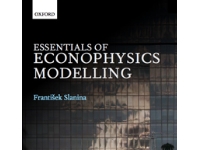Physics helps economy: a new monograph on Econophysics from the Institute of Physics, AS CR
Importance and impact of methods and techniques developed for studying physical problems has outreached the realm of natural sciences. Methods of quantum physics and statistical mechanics find more and more applications in biology, economy, informatics, or sociology. Physics has become one of the most important components of a number of new interdisciplinary research fields. Econophysics utilises methods of statistical mechanics and theory of phase transitions to model and understand processes in economy and financial markets.
Dr. František Slanina from the Condensed Matter Theory department of the Institute of Physics
of the Academy of Sciences of the Czech Republic, is one of the leading scientists in this field in
the Czech Republic. His own research contributed to the development of the field and is a
world-wide renowned expert. He was approach by representatives of the publishing house
Oxford University Press to write a monograph covering the state of the art of Econophysics.
After a few years of intense work, commitment and determination he finally succeeded
to complete the book
Essentials of Econophysics Modelling
that just was published in the
Oxford University Press.
This book is a course in methods and models rooted in physics and used in modelling economic
and social phenomena. It covers the discipline of econophysics, which creates an interface between
physics and economics. Besides the main theme, it touches on the theory of complex networks and
simulations of social phenomena in general.
After a brief
historical introduction, the book starts with a list of basic empirical data and proceeds to
thorough investigation of mathematical and computer models. Many of the models are based on
hypotheses of the behaviour of simplified agents. These comprise strategic thinking, imitation,
herding, and the gem of econophysics, the so-called minority game. At the same time, many other
models view the economic processes as interactions of inanimate particles. Here, the methods of
physics are especially useful. Examples of systems modelled in such a way include books of
stock-market orders, and redistribution of wealth among individuals. Network effects are
investigated in the interaction of economic agents. The book also describes how to model phenomena
like cooperation and emergence of consensus.
The book will be of
benefit to graduate students and researchers in both Physics and Economics. Its importance is
summarised by Prof. S. Solomon of Racah Institute of Physics of the Hebrew University in
Jerusalem:
František Slanina’s monumental monograph is the best up-to-date account of econophysics. The
author offers a clear, yet deep and complex view of the subject, its conceptual and technical
foundations, its past successes, and its future outlook. It is a must for anyone interested in
understanding or participating in the momentous current development of new interdisciplinary
methods for the study of economic phenomena.
Contact: František Slanina, Fyzikální ústav AV ČR, v. v. i., Na Slovance 2, CZ-182 21 Praha 8,
tel: +420 26605 2671, e-mail: slanina@fzu.cz







